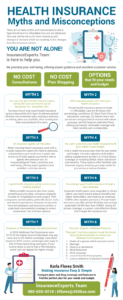 There are so many myths and misconceptions about Open Enrollment for Affordable Care Act and Medicare! This year will be even a bit more confusing with changes in the laws which are resulting in BIG changes from the Medicare insurance carriers.
There are so many myths and misconceptions about Open Enrollment for Affordable Care Act and Medicare! This year will be even a bit more confusing with changes in the laws which are resulting in BIG changes from the Medicare insurance carriers.
Myth 7 – Everyone on Medicare pays the same premium
 Most people who enroll in Medicare Part B, which covers doctor visits, diagnostic tests and other outpatient services, pay a standard monthly premium, $174.70 in 2024. But if your household income is above a certain amount, you may have to pay more than the basic monthly fee. If the government says your monthly tab is going to be higher, there are ways to appeal that decision.
Most people who enroll in Medicare Part B, which covers doctor visits, diagnostic tests and other outpatient services, pay a standard monthly premium, $174.70 in 2024. But if your household income is above a certain amount, you may have to pay more than the basic monthly fee. If the government says your monthly tab is going to be higher, there are ways to appeal that decision.
The added charge, known by the acronym IRMAA (income-related monthly adjustment amount) was included in the 2003 Medicare Modernization Act, designed to help financially stabilize the program. According to the Centers for Medicare & Medicaid Services (CMS), about 8 percent of Medicare beneficiaries are subject to these higher premiums.
“The idea is that people with higher levels of income should be paying more,” says Alex S. Seleznev, a wealth management specialist and certified financial planner.
CMS decides each year how much higher-income Medicare recipients will have to pay; the Social Security Administration (SSA) determines who must make those added payments.
The added charge is based on a beneficiary’s modified adjusted gross income (MAGI), which is your total adjusted gross income plus any tax-exempt interest that you report on your federal 1040 tax form. For example, individuals with annual incomes of $103,000 are subject to a higher premium in 2024, while the income threshold for joint filers is $206,000.
Here’s the tricky part: The SSA doesn’t use your most recent tax return to figure out whether you have to pay higher premiums. It looks back two years. That means the income on your 2022 tax return — filed in 2023 — will determine what you’ll have to pay in 2024.
Depending on your annual income, the amount you’ll have to pay above the standard Part B premium could range from $66.90 to $419.30 a month next year. The high-income charge also applies to Part D prescription drug coverage, and those extra charges could range from $12.90 to $81 a month, also based on your 2022 income. Part D plan premiums vary widely, depending on what plan you pick and where you live. These surcharges apply whether you are enrolled in original Medicare (Parts A and B) or a Medicare Advantage plan.
If the SSA decides you will have to pay a higher premium, the agency will send you a letter telling you how the surcharge was calculated, what to do if you believe the information used to calculate the premium adjustment is incorrect and what to do if your income has been reduced or you’ve had what the government calls a “life-changing event.”
7 Medicare Changes You’ll See in 2025
 You can thank the Inflation Reduction Act of 2022 for some of the biggest Medicare changes in the past few years — including a welcome reprieve from the high costs of prescription drugs.
You can thank the Inflation Reduction Act of 2022 for some of the biggest Medicare changes in the past few years — including a welcome reprieve from the high costs of prescription drugs.
Myth 6 – You only get good health insurance through a large company

Corporate health insurance plans were expanded in the past as a means to not only draw in but also retain high-caliber employees. These plans often come with extended coverage, encompassing elements like additional doctor visits, laboratory tests, and imaging, accompanied by manageable co-pays. However, it’s worth acknowledging that these comprehensive benefits come at a considerable cost, even when considering the employer’s contribution. In today’s world, corporate health plans exhibit a trend towards providing reduced benefits coupled with higher deductibles. This landscape typically offers employees a range of plan options varying in deductible amounts, co-insurance rates, and allowances for doctor visits and urgent care, among other factors. Customization is primarily limited to these variables.
Moreover, when an employee departs from a corporate health plan, they are granted the choice to enroll in COBRA, which essentially maintains their access to the same health insurance plan but at the full cost borne by the employee. To illustrate, if the monthly employee premium previously stood at $300, which the employer matched with $300, the employee’s COBRA premium would now be $600 per month. This signifies the plan while incurring twice the financial commitment. Additionally, it’s pertinent to note that often, associated life insurance benefits are lost as well.
In contrast, private health insurance plans extend a broader range of options to the insured, frequently at a more reasonable premium. In many cases, it proves advantageous for employees to forego COBRA and instead secure an independent private plan. Doing so can result in notable savings, often ranging between 30% to 50% of the employer’s COBRA plan costs. This approach offers a sensible and financially astute choice. And let’s not overlook the significance of maintaining your life insurance coverage in this decision-making process.
California May Regulate and Restrict Pharmaceutical Brokers
 “California Gov. Gavin Newsom will soon decide whether the most populous U.S. state will join 25 others in regulating the middlemen known as pharmacy benefit managers, or PBMs, whom many policymakers blame for the soaring cost of prescription drugs.
“California Gov. Gavin Newsom will soon decide whether the most populous U.S. state will join 25 others in regulating the middlemen known as pharmacy benefit managers, or PBMs, whom many policymakers blame for the soaring cost of prescription drugs.
PBMs have been under fire for years for alleged profiteering and anticompetitive conduct, but efforts to regulate the industry at the federal level have stalled in Congress.”
- « Previous Page
- 1
- …
- 5
- 6
- 7
- 8
- 9
- …
- 60
- Next Page »
